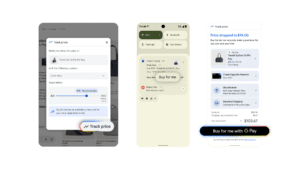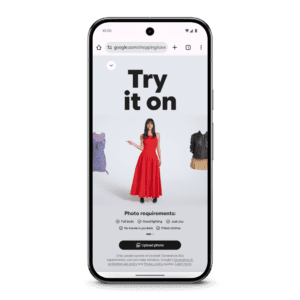Coinciding with Google’s annual I/O developer conference, the technology and search giant unveiled new ways it plans to use artificial intelligence (AI) in its shopping experiences.
Building on existing work with Google’s Gemini assistant, AI Mode and AI fitting tool, the company shared early looks in a post to its corporate blog. There, it shared how a new AI Search experience will work for shopping. It also detailed features planned for agentic checkout and the state of its virtual dressing room. The latter launches in the U.S. on May 20.
What Google’s AI Mode shopping experiences look like

Google AI shopping experience for a travel bag | Image credit: Google
“Today we introduced our new shopping experience in AI Mode with inspiring visuals, smart guidance and reliable product data,” said Lilian Rincon, vice president of consumer shopping product at Google. “We’re even giving shoppers a virtual dressing room and a new agentic checkout experience, so you can act quickly to make a purchase when the price is right for you.”
Google plans to launch its AI Mode in the U.S. “in the coming months,” according to its announcement. In doing so, it will leverage Gemini, along with its Shopping Graph for browsing and AI Search. AI Mode debuted with Google’s Search Labs to a limited user base in March. As it expands to the public, Google claims it has already amassed 50 billion product listings, Rincon stated. In addition, she said that more than 2 billion product listings will refresh on Google on an hourly basis.
Rincon used the example of a travel bag search, which could change with added context relevant to a shopper’s needs.
“It understands that you’re looking for visual inspiration and so it will show you a beautiful, browsable panel of images and product listings personalized to your tastes,” she explained. “If you want to narrow your options down to bags suitable for a trip to Portland, Oregon, in May, AI Mode will start a query fan-out, which means it runs several simultaneous searches to figure out what makes a bag good for rainy weather and long journeys, and then use those criteria to suggest waterproof options with easy access to pockets.”
How agentic checkout works

Google’s agentic checkout | Image credit: Google
Google’s new agentic commerce offering will incorporate a checkout experience. That checkout process can automate parts of the shopping journey based on selected parameters.
“When you’ve made up your mind, our new agentic checkout will help you easily buy at a price that fits your budget,” Rincon said. “Just tap ‘track price’ on any product listing and set the right size, color (or whatever options you prefer) and the amount you want to spend.”
“Keep an eye out for a price drop notification and, if you’re ready to buy, just confirm the purchase details and tap ‘buy for me,'” she noted. “Behind the scenes, we’ll add the item to your cart on the merchant’s site and securely complete the checkout on your behalf with Google Pay.”
Google’s new process for virtually trying on apparel

Google’s virtual try on tools | Image credit: Google
Previously, Google used generative AI to help retailers including H&M and Everlane to display their products. Those tools showed customers what products would look like on virtual models. Now, it is adding the option for shoppers to upload their own photos and use themselves as the models.
“This state-of-the-art technology is the first of its kind working at this scale, allowing shoppers to try on billions of items of clothing from our Shopping Graph,” Rincon said. “It’s powered by a new custom image generation model for fashion, which understands the human body and nuances of clothing — like how different materials fold, stretch and drape on different bodies.”
The latest virtual try-on options appear in Google’s Search Labs portal. Using them requires opting in to Google’s terms. Then, after doing so, shoppers can browse product listings, upload their photos and share the results.
“This virtual try-on technology bridges that gap, making it easier to shop with confidence,” said Priya Buening, head of U.S. ecommerce at Levi Strauss & Co. Buening highlighted Levi’s points of interest in a statement emailed to Digital Commerce 360.
Levi Strauss & Co. is No. 155 in Digital Commerce 360’s Top 2000 Database ranking the largest North American online retailers. The database categorizes Levi’s under Apparel & Accessories. Levi Strauss works with Google on other fronts as well.
“As Levi’s becomes a true denim lifestyle retailer, we’re always supportive of new ways to show fans how best to build their perfect outfits, from head to toe,” Buening said. “More and more people are shopping online, and it’s up to us — and innovative partners like Google — to evolve and perfect the online experience.
Do you rank in our databases?
Submit your data and we’ll see where you fit in our next ranking update.
Sign up
Stay on top of the latest developments in the ecommerce industry. Sign up for a complimentary subscription to Digital Commerce 360 Retail News. Follow us on LinkedIn, Twitter and Facebook. Be the first to know when Digital Commerce 360 publishes news content.
Favorite